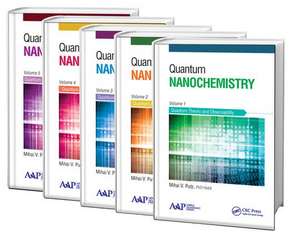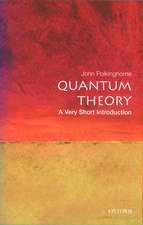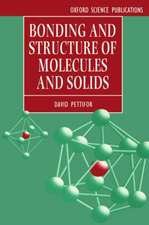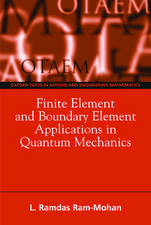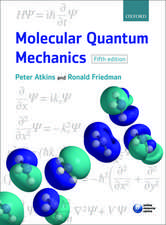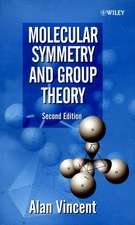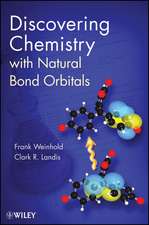Quantum Nanochemistry - Five Volume Set
Autor Mihai V. Putzen Limba Engleză Hardback – 13 mai 2016
The author approaches the systematics of atoms-in-molecule progressive modeling, in relation to chemical reactivity indices that are rooted in the electronegativity and chemical hardness prime chemical descriptors, with a refreshing and fruitful perspective. He considers the influence of chemical bonding and extends that to chemical-biological interaction in cells and organisms toward recording the biological activity. He covers the relevant connections with chemistry and atomic/molecular structures for the constituent particles/nodes in crystals and solids, including the hot topic of the propagation of defects on graphenes. The work is rigorously, thoughtfully, and analytically presented, with a flexible, instructive, and creative physical-chemical style of presentation and should be well understood by both physical and chemical communities in the nanosciences fields. These volumes will help to stimulate the creative power of the reader interested not just in knowing and understanding nature through the eyes of quantum theory but also in using the necessary know-how to predict and drive the quantum information, coined the nano-scale systems.
The multi-volume book uniquely features:
- A multi-level unitary approach (atoms, molecules, solids, and chemical-biological interaction in an interrelated conceptual and applicative presentation)
- Fresh quantum views and models of atomic stability and molecular reactivity
- A new theory of chemical bonding by bosonic-bondons
- The first path integral applications in quantum chemistry
- The first bondonic analysis for the graphenic topological defects
Preț: 4306.73 lei
Preț vechi: 5753.28 lei
-25% Nou
Puncte Express: 6460
Preț estimativ în valută:
824.35€ • 895.73$ • 692.90£
824.35€ • 895.73$ • 692.90£
Carte tipărită la comandă
Livrare economică 21 aprilie-05 mai
Preluare comenzi: 021 569.72.76
Specificații
ISBN-13: 9781771881388
ISBN-10: 1771881380
Pagini: 3097
Ilustrații: 92
Dimensiuni: 152 x 229 x 211 mm
Greutate: 5.51 kg
Ediția:1
Editura: Apple Academic Press Inc.
Colecția Apple Academic Press
ISBN-10: 1771881380
Pagini: 3097
Ilustrații: 92
Dimensiuni: 152 x 229 x 211 mm
Greutate: 5.51 kg
Ediția:1
Editura: Apple Academic Press Inc.
Colecția Apple Academic Press
Public țintă
Academic and PostgraduateCuprins
Volume 1: Quantum Theory and Observability. Volume 2: Quantum Atoms and Periodicity. Volume 3: Quantum Molecules and Reactivity. Volume 4: Quantum Solids and Orderability. Volume 5: Quantum Structure-Activity Relationships (Qu-SAR).
Notă biografică
Mihai V. Putz, PhD is a laureate in physics (1997), with an MS degree in spectroscopy (1999), and PhD degree in chemistry (2002), with many post-doctorate stages: in chemistry (2002-2003) and in physics (2004, 2010, 2011) at the University of Calabria, Italy, and Free University of Berlin, Germany, respectively. He is currently associate professor of theoretical and computational physical chemistry at West University of Timisoara, Romania. He has made valuable contributions in computational, quantum, and physical chemistry through seminal works that appeared in many international journals. He actively promoted a new method of defining electronegativity, DFE (Density Functional Electronegativity), among new enzyme kinetics (Logistic Enzyme Kinetics), a new formalization of the structure-activity relationship (SPECTRAL-SAR) model, and recently the bondonic quasi-particle theory of the chemical bonding first application on nanosystems as graphene, all seeking for a unitary quantum approach of the chemical structure and reactivity targeting the bio-, pharmaco-, and ecological analytical description. He is editor-in-chief of the International Journal of Chemical Modelling and the International Journal of Environmental Sciences. He is member of many professional societies and has received several national and international awards from the Romanian National Authority of Scientific Research (2008), the German Academic Exchange Service DAAD (2000, 2004, 2011), and the Center of International Cooperation of Free University Berlin (2010). He is the leader of the Laboratory of Computational and Structural Physical Chemistry for Nanosciences and QSAR at Biology-Chemistry Department of West University of Timisoara, Romania, where he conducts research in the fundamental and applicative fields of quantum physical-chemistry and QSAR. In 2010 Mihai V. Putz was declared through a national competition the Best Researcher of Romania, while in 2013 he was recognized among the first Dr. Habil. in Chemistry in Romania. In 2013 he was appointed scientific director of the newly founded Laboratory of Structural and Computational Physical Chemistry for Nanosciencs and QSAR in his alma mater of West University of Timisoara, while from 2014, he was recognized by the Romanian Ministry of Research as principal investigator of the first degree, and also becoming full member of the International Academy of Mathematical Chemistry.
Recenzii
"Overall, these five volumes cover a lot of material and work well to unite physicists and chemists as quantum scientists. . . . Dr. Putz has drawn on his peer-reviewed papers, lectures, conversations, and other sources to write a five-volume set entitled Quantum Nanochemistry. In these volumes, Professor Putz aims to illuminate the physical underpinnings of matter. While the properties and interactions of matter have been well-described by many classical theories, quantum theory is needed to describe matter below the atomic scale. In these volumes, Professor Putz hopes to unite materials scientists, physicists, chemists, and others as quantum scientists, who use analytical descriptions of matter to inform their work. Concepts and ideas from engineering and materials science are mixed with those from chemistry and the history of science. . . . These books reduce all concepts to mathematic and analytic descriptions whenever possible, so readers will be able to follow the main themes, especially for those with a strong background in physics and mathematics. The books heavily reflect the author’s presentations and past work, yet the later volumes draw extensively from the literature. The books include many references for interested parties to explore. The books also include a number of informative tables and figures that could serve as helpful references; however, despite the emphasis on teaching and describing analytic work, there are no example problems given."
—Structural Chemistry, by Benjamin D. Smith, Department of Chemistry, Science Center, Saint Francis University, Loretto, PA
"This book, with its 2889 pages in five volumes, represents an impressive piece of work written by a single author. The wide variety of topics covered by the book reveals the author’s deep and encyclopedic knowledge of quantum theory. The author identifies himself as a theoretical physicist, and characterizes his book as a compilation of his lecture notes which he has used within his classes. The author’s favorite topics can be easily recognized in all five volumes. The sections on the history of quantum theory examine concepts and fundamental quantum theories in retrospect, and may prove useful and amusing reading for lecturers teaching quantum theory. Moreover, the unconventional look at some problems related to quantum theory may prove inspiring for experts actively working in the field. Students may find some useful material in the book . . . "
—International Journal of Molecular Sciences, by Petr Čársky, J. Heyrovský Institute of Physical Chemistry, Academy of Sciences of the Czech Republic, Prague, Czech Republic
—Structural Chemistry, by Benjamin D. Smith, Department of Chemistry, Science Center, Saint Francis University, Loretto, PA
"This book, with its 2889 pages in five volumes, represents an impressive piece of work written by a single author. The wide variety of topics covered by the book reveals the author’s deep and encyclopedic knowledge of quantum theory. The author identifies himself as a theoretical physicist, and characterizes his book as a compilation of his lecture notes which he has used within his classes. The author’s favorite topics can be easily recognized in all five volumes. The sections on the history of quantum theory examine concepts and fundamental quantum theories in retrospect, and may prove useful and amusing reading for lecturers teaching quantum theory. Moreover, the unconventional look at some problems related to quantum theory may prove inspiring for experts actively working in the field. Students may find some useful material in the book . . . "
—International Journal of Molecular Sciences, by Petr Čársky, J. Heyrovský Institute of Physical Chemistry, Academy of Sciences of the Czech Republic, Prague, Czech Republic
Descriere
This new 5-volume set presents in a balanced yet progressive manner the fundamental and advanced concepts, principles, and models of quanta, atoms, molecules, solids, and crystal and chemical-biological interaction in cells. It also addresses the first and novel combinations and applications in modeling complex natural or designed phenomena. These new volumes by Dr. Putz embrace the best knowledge at the dawn of the twenty-first century of chemical bonding approaches while further advancing the chemical bonding approaches through the author’s own progressive vision, which highlights the concept of bosonic-bondon in artificial chemistry.
